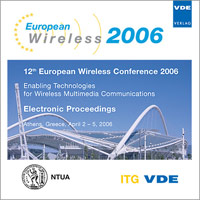Distributed Organization of Cooperative Antenna Systems
Konferenz: European Wireless 2006 - 12th European Wireless Conference 2006 - Enabling Technologies for Wireless Multimedia Communications
02.04.2006 - 05.04.2006 in Athens, Greece
Tagungsband: European Wireless 2006
Seiten: 6Sprache: EnglischTyp: PDF
Persönliche VDE-Mitglieder erhalten auf diesen Artikel 10% Rabatt
Autoren:
Zirwas, Wolfgang; Schulz, Egon; Kim, Jee Hyun (Siemens AG, COM MN PG NT RI4, St.-Martin-Str. 76, D-81541 Munich)
Jungnickel, Volker; Schubert, Martin (Fraunhofer Institute for Telecommunications, HHI, Einsteinufer 37, D-1087 Berlin, Germany)
Inhalt:
Cooperative antenna systems have become a hot research topic and promise significant performance gains w.r.t. throughput and capacity. For cellular mobile radio systems the so called service area concept (SA) – a multi user MIMO (MU-MIMO) approach - is very promising. Several adjacent base stations (BS) are tightly coupled over the backbone network. A joint transmission/joint detection (JT/JD) algorithm located in a central unit (CU) calculates a common weighting matrix for all BS of an SA allowing to serve several mobile stations (MS) simultaneously. This results in a real frequency reuse equal to 1 or near to 1. Normally it is assumed that the backbone provides the fast interconnection of the BS and the CU for calculation of the weighting matrix. The drawback of this solution is that this results in a hierarchical network structure which – while available in today’s 2G or 3G networks with the radio network controller (RNC) – is something network planer want to get rid off for future enhancements like 3GPP UTRA long term evolution (LTE). Here instead of a hierarchical higher CU a de-centrally over the air organized distributed cooperative radio system is proposed, minimizing the requirements to the backbone network.


